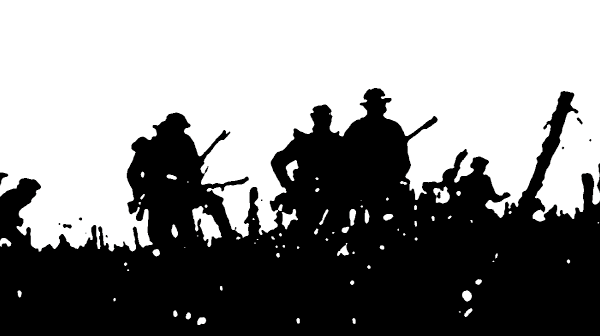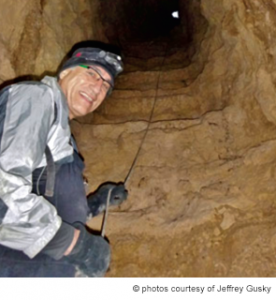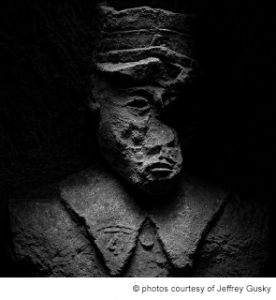
In late summer 1914, as World War I began, Europeans on both sides of the conflict greeted war with unrestrained zeal. The common belief was that the war would be over by Christmas. But by the end of the year, a million were dead and there was no end in sight. It was the world’s first encounter with the dark side of modern progress and the first modern mass destruction.
Explore This Issue
ACEP Now: Vol 33 – No 12 – December 2014
Former underground city beneath the trenches. Photographed March 11, 2013. Picardy, France.
Until this past summer, few knew of the existence of a hidden world of World War I—that is, until the discoveries and photographs of Dallas emergency physician Jeffrey Gusky, MD, FACEP, were featured in National Geographic magazine and The New York Times and on BBC television (http://www.bbc.com/news/world-29409433).

WWI soldiers’ graffiti. Photographed Jan. 30, 2013. Picardy, France.
In haunting black-and-white images, Dr. Gusky has documented the art and artifacts left behind by troops in hundreds of underground cities beneath the former trenches of the Western Front in France. A fine-art photographer, emergency physician, and explorer, Dr. Gusky gained the trust of French farmers under whose land are buried these testaments to the hopes, dreams, and fears of tens of thousands of soldiers from both sides who lived and worked there throughout the war.
The images are striking: panoramic shots of miles-long subterranean cities, an abandoned dining table still set with wine bottles and canteens, a pencil drawing of lovers kissing, and a bas-relief sculpture of a French soldier whose face is half gone.
Dr. Gusky hopes that through his efforts, we will become aware of the compelling parallels between then and now. “My work as a fine-art photographer is very much about helping people to see how modern life can blind us to danger,” he said.

Dr. Gusky during a photo shoot, at the base of a stairway leading from tunnels to the trenches above ground.
An Intuitive Switch
Dr. Gusky’s interest in fine-art photography was sparked by an emergency department colleague’s collection of black-and-white photography. In 1995, Dr. Gusky decided to tour Nazi concentration camps during the harsh Polish winter. Just before leaving, he bought a professional-grade camera body and a single lens. On a bitterly cold, overcast day at Płaszów concentration camp, depicted in the movie Schindler’s List, he discovered a small part of the camp that was largely unknown, even to locals. “That place is where my second career as a fine-art photographer began,” he said. “It was as if an intuitive switch flipped on inside, and it has remained on since.” Dr. Gusky explained that he had photographed what he felt in that haunted place, using his intuition as a guide. When he returned to Texas and others saw these photographs, “they also described them as haunted. There was a level of emotion that people could feel.” Dr. Gusky said.
Connection to the Bedside
Since 1995, Dr. Gusky has visited and documented many sites where modern genocide and mass destruction have occurred. “What underlies events in all these places—Poland, Moldova, Romania, the battlefields of World War I in France and Belgium—is what happens when people become dehumanized by the incomprehensible scale of modern life,” he observed.

French
soldiers’ dining area underground with wine bottles, canteens, and a serving dish. Photographed Dec. 6, 2011. Vauquois, France.
“My photography is very connected to what I do at the bedside,” he said. “Instead of working with one patient and a family, I have the privilege of touching mass audiences, but the driving force behind it all is identical to my mission in the ED. Helping people to see and understand how modern life can blind us to the dark side of modern progress is another way to save lives.
“ED docs are privileged to form an intimate bond with complete strangers in a moment of time. There’s a sacred quality to it. There is no place for political correctness. It is not about right or left, rich or poor, black or white, gay or straight, American or foreign. We strive to treat everyone with the same decency and respect as fellow human beings. We guide patients and their families on a journey through darkness to light that’s always toward hope. Where else does that role exist in society?”
Leaving Something for the Future
During his trips to rural France, Dr. Gusky gradually earned the trust of local people who shared their secrets. He was granted exclusive access to photograph many unknown places beneath the Western Front, almost all of them on private land. To honor the trust and protect these cultural treasures from theft, he is tight-lipped about their exact locations.
The landowners often accompany him on photo shoots, which take place in total darkness and are sometimes dangerous. “Some of the underground cities are so vast, one could easily lose their way in the darkness,” he said. Although he doesn’t speak French and his hosts do not speak English, “the photographs are a creative language we all shared. Making the photographs created an indelible bond. We all felt like we were leaving a legacy, leaving something for the future.”
“The photographs are a creative language we all shared. Making the photographs created an indelible bond. We all felt like we were leaving a legacy, leaving something for the future.”
Dr. Gusky is a full-time emergency physician with Altus Emergency Centers in the Houston area but resides in Dallas. He condenses two months of shifts into two weeks, allowing him to pursue his second career as an artist and explorer. He believes that physicians who wish to deepen their creativity can draw upon the rigor and discipline of medical training. “Medicine teaches us to be relentlessly curious, to live on the frontline of life, and to continuously advance our knowledge.”

Sculpture of French soldier wearing uniform of 1914. Photographed Jan. 16 2014. Picardy, France.
Glimpsing the hidden world of World War I through his photographs, Dr. Gusky believes, can underscore the powerful lessons of history. Prior to World War I , he said, “people were intoxicated by progress and modern technology. They believed that science was an inexorable force that could do only good. Then they experienced the dark side of modern progress when all the technologies that made life efficient, exhilarating, and powerful were deployed in service of mass destruction on an incomprehensible scale.” Emergency physicians can “inspire others to be courageous and remain hopeful when the world seems to be falling apart around them. We are privileged to work on a frontline of modern life and have a duty and a responsibility to model what it means to be human in an inhuman world.”
For more images and information, visit http://jeffgusky.com/ and https://www.facebook.com/HiddenWWI. Dr. Gusky will be releasing a new photograph from his collection, entitled “The Hidden World of WWI,” every day on Facebook through the end of the WWI Centenary in 2019.
Gretchen Henkel is a medical journalist based in California.
Pages: 1 2 3 | Multi-Page



No Responses to “Emergency Physician Documents Hidden World War I Art, Artifacts in Photographs”